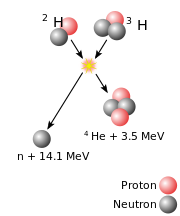Deuterium–tritium fusion

Deuterium–tritium fusion (sometimes abbreviated D+T) is a type of
Tritium, one of the reactants required for this type of fusion, is
Concept
In deuterium–tritium fusion, one
The mass difference between D+T and neutron+4He is described by the semi-empirical mass formula that describes the relation between mass defects and binding energy in a nucleus.
Discovery
Evidence of the D+T reaction was first detected at the University of Michigan in 1938 by Arthur Ruhlig.[2][non-primary source needed] His experiment detected the signature of neutrons with energy greater than 15 MeV in secondary reactions of tritium created in HH reactions of a 0.5 MeV
Reactant sourcing
About 1 in every 5,000 hydrogen atoms in seawater is deuterium, making it easy to acquire.[1][4]
Use in fusion reactors
Deuterium–tritium fusion is planned to be used in ITER,[6] as well as many other proposed fusion reactors. It provides many advantages over other types of fusion, as it has a relatively low minimum temperature of 100 million degrees C.[8]
See also
References
- ^ a b c "Nuclear Fusion". Georgia State University. Retrieved January 29, 2021.
- . Retrieved February 6, 2024.
- ^ Paris, Mark W and Chadwick, Mark B (2023). "A lost detail in D-T fusion history". Physics Today. 76 (10). {AIP Publishing}: 10–11.
{{cite journal}}: CS1 maint: multiple names: authors list (link) - ^ a b Lanctot, Matthew. "DOE Explains...deuterium–tritium Fusion Reactor Fuel". Department of Energy. Retrieved April 12, 2021.
- ^ Cowley, Steve. "Introduction to Fusion Part I." (PDF). SULI. Retrieved January 30, 2021.
- ^ a b "Fueling the Fusion Reaction". ITER. Retrieved February 12, 2021.
- ^ "Tritium: a challenging fuel for fusion". EUROfusion. November 8, 2017. Retrieved February 16, 2021.
- ^ Schneider, Ursula (August 1, 2001). "Fusion: Energy of the Future". International Atomic Energy Agency. Retrieved February 13, 2021.





